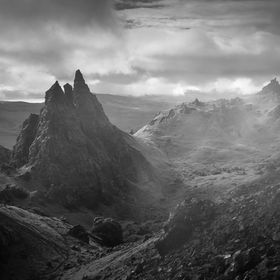grahamharrisgraham
FollowA sail boat heads west towards the brooding mountains of Argyll, Scotland
A sail boat heads west towards the brooding mountains of Argyll, Scotland
Read less
Read less
Views
832
Likes
Awards
Featured
Contest Finalist in 300 Vessels Photo Contest
Peer Award
Superb Composition
Outstanding Creativity
Top Choice
Absolute Masterpiece
Superior Skill
Magnificent Capture
Top Ranks
Categories
Same photographer See allBehind The Lens
Discover more photos See all
Behind The Lens
Location
I captured this scene near the village of Baile a' chaolais, (Scots Gaelic, meaning “settlement on the strait”) in Lochaber region, Scotland. In the 1600's, the village became synonymous with slate mining from which the dark grey sheets of stone were used to roof buildings all over Scotland. The elevated position was courtesy of a bridge that crosses the fast moving tidal waters of Loch Liobhan, known as Caolas Mag Phadraig (meaning "Patrick’s narrows"). The view looks due west towards the rugged parish of Àird Ghobhar, (meaning "height of the goats") on Scotland's most westerly Atlantic facing peninsula called Àird nam Murchan (headland of the great seas), a region strongly associated with the Clan McLean since the 1500s. From here, it is possible to sail out of the sheltered, inner sea lochs & eventually into the intimidating seas of the Atlantic Ocean.Time
It was captured about mid morning in early autumn when most of the tourist traffic has diminished to a trickle, thus reducing the vibration on the old metal bridge. I nearly always use a tripod but here, I wedged the camera firmly against the metal girders, waiting for this solitary sail boat to glide beneath me. But a small gamble was needed to pick the position before knowing exactly where the boat would emerge, by which time, it might have been too late to reposition before the boat diminished to nothing more than a moving dot on the water. I then waited until the boat had formed a pleasing wake behind it, but not too wide such that the boat by then would probably be unrecognisable.Lighting
Scotland sits further north on the globe than many realise, between 55 & 60 degrees latitude. The consequence is that the sun, even in summer, stands rather low in the sky. In the winter, it barely scrapes over the horizon. The consequence is strong, low angled sunlight throughout much of the year, often negating the need to get up at silly hours in the morning to take advantage of more dramatic light. Here, light from the left, picks its way through typical heavy maritime cloud to illuminate the shimmering waters while leaving the hills in the distance, heavy, moody & foreboding.Equipment
I used a Canon 5D Mark ii camera & the only wide angle lens I have, a Canon TS-E 24mm f/3.5L tilt-shift lens. Despite the heavy cloud, it was still reasonably bright due to the water, so I wedged the camera against the ironwork of the bridge & set the lens to f8. I set the camera to ISO 50 which gave a shutter speed of 1/30 sec, plenty fast enough to prevent the receding boat from blurring during the exposure.Inspiration
Lochaber is famous in Scotland for its dramatic mountain scenery, deep see lochs, upland bogs & steep glens, the most famous of which, is Glencoe. I have driven this route many times, lured by it dangerous winter weather, dramatic light & fabulous scenery, but was determined to add at least one nautical themed image to my portfolio. But this one was almost by chance, despite the lochs being home to many small fishing & sail boats. Sometimes, you just need a bit of luck & I got some after driving for two hours from my home at that time, in the small town of Stirling.Editing
I capture everything in RAW format & then process the files in Lightroom. It's an easy program to use & has become rather sophisticated over the last few years without getting too gimmicky. In this instance, it was captured in colour but some images just work better in B&W, especially those with clear linear form such as this one, with strong diagonal lines created by the wake on the water. I shoot lots of colour work too but I use a simple test to determine when to convert. If the colours don't add anything, (seasonal cues, mood, atmosphere, etc) then I don't need them.In my camera bag
Canon 5D mark ii & EF24mm TS-E f3.5L, EF50mm f1.2L, EF 85mm f1.2L & EF 135 f2.0L. And a Metz 76 MZ-5 to illuminate the occasional monument or small castle at dusk. The tripod is a heavy Manfrotto 055XPROB. I don't use graduated filters for two reasons (1) I can't understand how anyone can charge that much for Columbia Resin 39, a plastic that was invented in the 1940's. (2) For the type of images I like to capture, I don't need them.Feedback
Taking any camera out, at any time of day, in any weather is eventually going to result in something that you like rather than staying at home, wishing you had gone out, usually after it is too late. But expecting to build a pleasing portfolio based entirely upon chance is bound to end in disappointment. Before I go anywhere, I usually have the image already captured in my head, definitely not in the camera. It is then a matter of studying location, solar charts, tidal charts, weather forecasts, topography & picking your preferred time to go. It doesn't always go to plan but if it were that easy, everyone would be good at it, right?











































